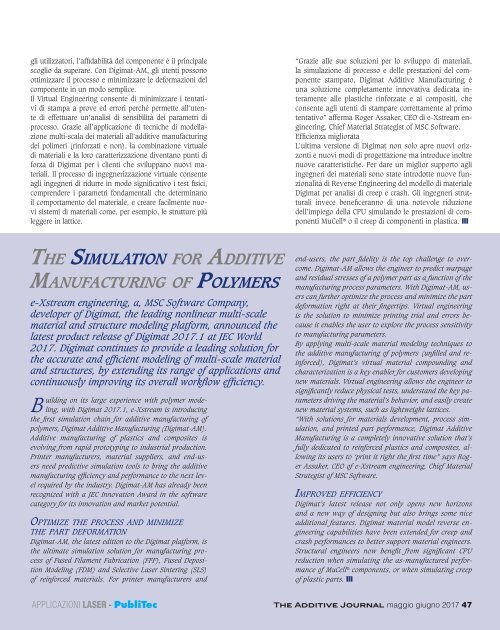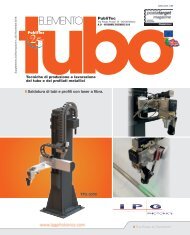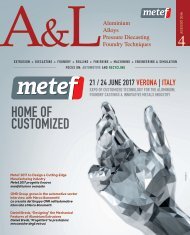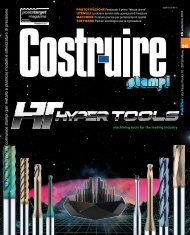Sfogliabile_Applicazioni_Laser_maggio_57
You also want an ePaper? Increase the reach of your titles
YUMPU automatically turns print PDFs into web optimized ePapers that Google loves.
gli utilizzatori, l’affidabilità del componente è il principale<br />
scoglio da superare. Con Digimat-AM, gli utenti possono<br />
ottimizzare il processo e minimizzare le deformazioni del<br />
componente in un modo semplice.<br />
Il Virtual Engineering consente di minimizzare i tentativi<br />
di stampa a prove ed errori perché permette all’utente<br />
di effettuare un’analisi di sensibilità dei parametri di<br />
processo. Grazie all’applicazione di tecniche di modellazione<br />
multi-scala dei materiali all’additive manufacturing<br />
dei polimeri (rinforzati e non), la combinazione virtuale<br />
di materiali e la loro caratterizzazione diventano punti di<br />
forza di Digimat per i clienti che sviluppano nuovi materiali.<br />
Il processo di ingegnerizzazione virtuale consente<br />
agli ingegneri di ridurre in modo significativo i test fisici,<br />
comprendere i parametri fondamentali che determinano<br />
il comportamento del materiale, e creare facilmente nuovi<br />
sistemi di materiali come, per esempio, le strutture più<br />
leggere in lattice.<br />
“Grazie alle sue soluzioni per lo sviluppo di materiali,<br />
la simulazione di processo e delle prestazioni del componente<br />
stampato, Digimat Additive Manufacturing è<br />
una soluzione completamente innovativa dedicata interamente<br />
alle plastiche rinforzate e ai compositi, che<br />
consente agli utenti di stampare correttamente al primo<br />
tentativo” afferma Roger Assaker, CEO di e-Xstream engineering,<br />
Chief Material Strategist of MSC Software.<br />
Efficienza migliorata<br />
L’ultima versione di Digimat non solo apre nuovi orizzonti<br />
e nuovi modi di progettazione ma introduce inoltre<br />
nuove caratteristiche. Per dare un miglior supporto agli<br />
ingegneri dei materiali sono state introdotte nuove funzionalità<br />
di Reverse Engineering del modello di materiale<br />
Digimat per analisi di creep e crash. Gli ingegneri strutturali<br />
invece beneficeranno di una notevole riduzione<br />
dell’impiego della CPU simulando le prestazioni di componenti<br />
MuCell ® o il creep di componenti in plastica. yyy<br />
the simulation for aDDitive<br />
manufacturing of polymers<br />
e-Xstream engineering, a, MSC Software Company,<br />
developer of Digimat, the leading nonlinear multi-scale<br />
material and structure modeling platform, announced the<br />
latest product release of Digimat 2017.1 at JEC World<br />
2017. Digimat continues to provide a leading solution for<br />
the accurate and efficient modeling of multi-scale material<br />
and structures, by extending its range of applications and<br />
continuously improving its overall workflow efficiency.<br />
Building on its large experience with polymer modeling,<br />
with Digimat 2017.1, e-Xstream is introducing<br />
the first simulation chain for additive manufacturing of<br />
polymers, Digimat Additive Manufacturing (Digimat-AM).<br />
Additive manufacturing of plastics and composites is<br />
evolving from rapid prototyping to industrial production.<br />
Printer manufacturers, material suppliers, and end-users<br />
need predictive simulation tools to bring the additive<br />
manufacturing efficiency and performance to the next level<br />
required by the industry. Digimat-AM has already been<br />
recognized with a JEC Innovation Award in the software<br />
category for its innovation and market potential.<br />
Optimize the prOcess and minimize<br />
the part defOrmatiOn<br />
Digimat-AM, the latest edition to the Digimat platform, is<br />
the ultimate simulation solution for manufacturing process<br />
of Fused Filament Fabrication (FFF), Fused Deposition<br />
Modeling (FDM) and Selective <strong>Laser</strong> Sintering (SLS)<br />
of reinforced materials. For printer manufacturers and<br />
end-users, the part fidelity is the top challenge to overcome.<br />
Digimat-AM allows the engineer to predict warpage<br />
and residual stresses of a polymer part as a function of the<br />
manufacturing process parameters. With Digimat-AM, users<br />
can further optimize the process and minimize the part<br />
deformation right at their fingertips. Virtual engineering<br />
is the solution to minimize printing trial and errors because<br />
it enables the user to explore the process sensitivity<br />
to manufacturing parameters.<br />
By applying multi-scale material modeling techniques to<br />
the additive manufacturing of polymers (unfilled and reinforced),<br />
Digimat’s virtual material compounding and<br />
characterization is a key enabler for customers developing<br />
new materials. Virtual engineering allows the engineer to<br />
significantly reduce physical tests, understand the key parameters<br />
driving the material’s behavior, and easily create<br />
new material systems, such as lightweight lattices.<br />
“With solutions for materials development, process simulation,<br />
and printed part performance, Digimat Additive<br />
Manufacturing is a completely innovative solution that’s<br />
fully dedicated to reinforced plastics and composites, allowing<br />
its users to ‘print it right the first time” says Roger<br />
Assaker, CEO of e-Xstream engineering, Chief Material<br />
Strategist of MSC Software.<br />
imprOved efficiency<br />
Digimat’s latest release not only opens new horizons<br />
and a new way of designing but also brings some nice<br />
additional features. Digimat material model reverse engineering<br />
capabilities have been extended for creep and<br />
crash performances to better support material engineers.<br />
Structural engineers now benefit from significant CPU<br />
reduction when simulating the as-manufactured performance<br />
of MuCell ® components, or when simulating creep<br />
of plastic parts. yyy<br />
APPLICAZIONI LASER - PubliTec<br />
The Additive Journal <strong>maggio</strong> giugno 2017 47





